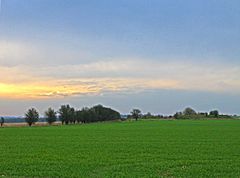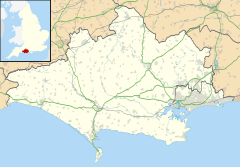Wor Barrow facts for kids

Viewed from the north-west
|
|
| Location | near Sixpenny Handley, Dorset |
|---|---|
| Coordinates | 50°57′18.7″N 1°59′1.9″W / 50.955194°N 1.983861°W |
| History | |
| Periods | Neolithic |
| Site notes | |
| Excavation dates | 1893–1894 |
| Archaeologists | Augustus Pitt Rivers |
| Designated | 11 November 1954 |
| Reference no. | 1020066 |
Wor Barrow is a very old burial mound from the Neolithic period. This was a time when people first started farming. It's located on Cranborne Chase in Dorset, England. This ancient site is about 1 mile east of Sixpenny Handley. It is a special place protected by law, called a scheduled monument.
Archaeologists dug up Wor Barrow in 1893–1894. This dig was led by Augustus Pitt Rivers. Experts say his work was very important for understanding British history.
What is Wor Barrow?
Cranborne Chase has many ancient sites from the Neolithic and Early Bronze Age. These are periods when people used stone tools. Wor Barrow is a type of burial mound called a long barrow. It's shaped like a long, low hill.
Nearby, you can find two bowl barrows. These are smaller, round burial mounds. There are also many round barrows at Oakley Down to the east. Wor Barrow might have influenced where these other mounds were built.
Wor Barrow was built between 3400 and 2400 BC. It runs from the north-west to the south-east. It was originally about 45 meters (148 feet) long. It was also about 23 meters (75 feet) wide. The mound stood about 3 meters (10 feet) high. A ditch surrounded the barrow. This ditch was 3 to 7.5 meters (10 to 25 feet) wide. It was also up to 4 meters (13 feet) deep.
Digging Up the Past: Wor Barrow's Secrets
Augustus Pitt Rivers owned the Rushmore Estate. He lived there starting in 1880. He spent a lot of time exploring ancient sites on his land. He completely dug up Wor Barrow. He excavated the ditch in 1893 and the mound in 1894. He wrote down all his findings in great detail.
Inside the ditch, archaeologists found two burials from the Early Neolithic period. They also found layers of pottery from different times. This showed how the site changed over many years. Some burials from the Roman-British period were also found there.
The upper parts of the mound also held Roman-British burials. Below these, they found something very interesting. There were traces of a rectangular wooden fence or building. It was about 27 by 10 meters (89 by 33 feet). This wooden area was once covered by a mound of earth and grass. It had an entrance on the south-east side. Inside, they found six male skeletons. Three of these skeletons were not complete or in their natural position.
Archaeologists believe the wooden enclosure was the first thing built. It was surrounded by its own rectangular ditch. Later, the large barrow was built over this wooden area. The new barrow's ditch partly destroyed the older ditch.
The soil dug out during the excavation was placed in a terraced bank. This bank was along the south-west side of the barrow. Pitt Rivers wanted the site to be like an amphitheater. He hoped it could be used for "games or other amusements."


